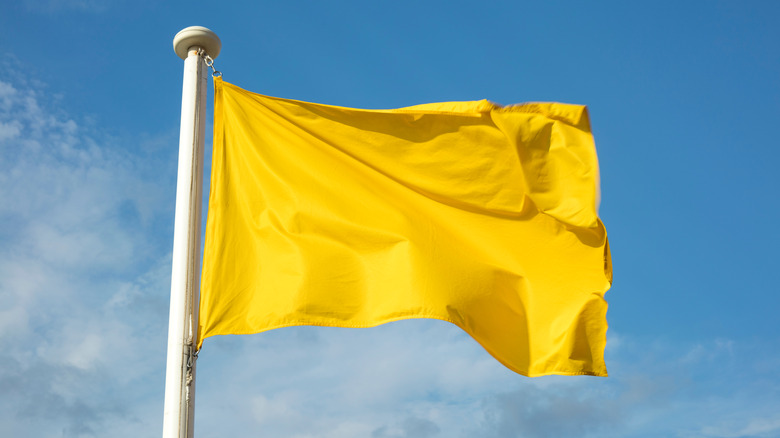What It Really Means When You See A Yellow Flag At The Beach
A day at the perfect beach is good for the soul. The shining sun provides a dose of Vitamin D, and the feel of crashing waves can be precisely what you need to lift your spirits. A caveat could put a damper on these plans: beach warning flags. Perhaps you've seen them sticking out in the sand and have ignored them. This is not advised, as lifeguards place the flags to alert beachgoers on surf conditions. The flags are a common sight in Florida, home to underrated beach vacation spots. One flag color you'll typically come across is yellow.
Psychologically speaking, the color yellow has a positive connotation. But if you see a yellow flag at the beach, you'll want to be wary about jumping into the ocean for a swim. This denotes that swimmers can expect a high surf and the possibility of rip currents. In other words, visitors should be aware of some danger involved if they step foot in the ocean. However, it's not enough for lifeguards to feel that nobody should be in the water.
For that, they would use a red flag or, if conditions are extreme, a double red flag to indicate the ocean is entirely off-limits. Nevertheless, if you see a yellow flag at the beach, you should know how to keep yourself and others safe.
Know before you go to the beach
If you decide to swim in the presence of a yellow flag, be aware that you could be pulled further into the ocean by a rip current. Rip currents are incredibly fast, and you might not see one coming. Tragically, the National Weather Service (via The Washington Post) states that rip currents account for 71 deaths annually. If you find yourself in a rip current, try not to panic and keep yourself afloat. If you can, call for help.
Most importantly, don't swim in the direction of the shore but rather parallel to it. If you witness someone getting caught in a rip current, stay away from the water and find a lifeguard. It goes without saying that if swimming isn't your forte, and there's a yellow flag at the beach, it would perhaps be in your best interest to stay out of the water for your safety. Alternatively, you could wear a life jacket as a proactive measure and swim with a buddy or near the presence of a lifeguard.
Likewise, if you see a yellow flag and have doubts about whether you should be swimming or not, ask the lifeguard. They should be able to provide you with more insight into the day's surf conditions. Besides yellow and red, you might see a green or purple flag at the beach. The former represents ideal swimming conditions, and the latter signifies that you could encounter aquatic creatures in the water.

